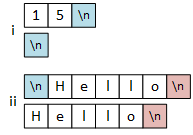 | ||
#include <iostream>
#include <string>
using namespace std;
int main()
{
int i1;
cout << "Enter the first number: ";
cin >> i1;
string s1;
cout << "Enter the first string: ";
getline(cin, s1);
cout << s1 << endl;
return 0;
}
|
#include <iostream>
#include <string>
using namespace std;
int main()
{
int i1;
cout << "Enter a number: ";
cin >> i1;
cin.ignore();
string s1;
cout << "Enter the first string: ";
getline(cin, s1);
cout << s1 << endl;
return 0;
} |
#include <iostream>
#include <string>
using namespace std;
int main()
{
string s1;
cout << "Enter the first string: ";
cin.ignore();
getline(cin, s1);
cout << s1 << endl;
return 0;
}
|
| (a) | (b) | (c) |
- The first input statement (light blue) reads an integer from the input stream but leaves the trailing newline character (i). The getline function (pink) reads and discards the leading newline character (ii), ending the call without reading a string.
- The cin statement (light blue) reads an integer but leaves the newline character in the input stream (i). The ignore function (pink) discards the leading newline (ii), allowing the getline (yellow) to read the string successfully.
- The behavior of example (b) tempts to adopt a simple strategy: always call ignore (pink) before getline (light blue). This simple program demonstrates that the strategy doesn't always work. Without a newline left from a previous input operation (i), the input stream looks similar to (ii) but without the leading newline. Therefore, the the ignore function discards the first character of the string, H, and the program saves and prints ello.